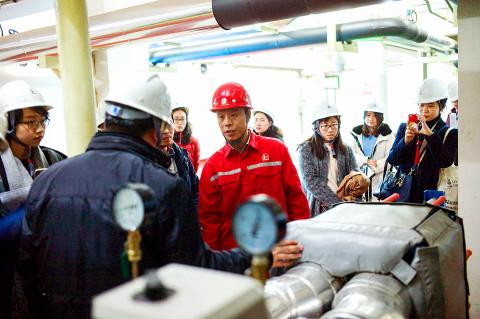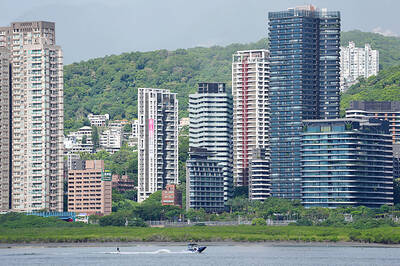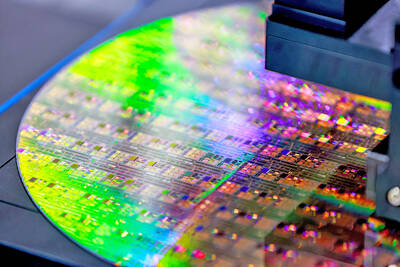Chinese state-run energy giant Sinopec Corp (中國石油化工) has drilled hundreds of wells across the country without finding a single drop of oil, but that was precisely the point: Instead of black gold, the about 1km deep holes are providing clean heat for local homes.
While two-thirds of China’s electricity is generated by coal, almost all of the homes in Hebei Province’s Xiong District — home to 400,000 people — are heated by wells as deep as 1.5km.
In a new apartment in the district, a 60-year-old retiree watched his granddaughters hop about in bare feet, impervious to the frost outside.

Photo: AFP
“This floor heating works like a dream,” Li Fuzeng said. “And they say it’s clean energy.”
The temperature inside his home was 28oC and a citrus tree in the corner showed no signs of winter.
Chen Menghui, director of Sinopec’s geothermal branch in Hebei, said the process depends on a cycle of running water.
“These underground wells are pumped with water, which comes out at a temperature of about 70oC before flowing into the heating system,” he said.
Though experts have said there is immense potential in China’s subterranean heat reserves, they remain largely unexploited, accounting for less than 0.5 percent of the nation’s energy consumption.
Sinopec’s geothermal projects in China make up for more than 40 percent of the total number of homes heated by geothermal energy in the country, making them a potential model for how it can tap this resource.
Before launching itself into the geothermal industry, Sinopec found an unusual partner in the Icelandic company Arctic Green Energy Corp.
Sinopec needed technical support and Iceland is regarded as the leader in extracting energy from the ground. In a joint venture beginning in 2009, they invested 400 million yuan (US$58 million) into the Xiong project, where they drilled about 70 wells.
The idea was to apply the technology that had already been tested in the Nordic country to northern China.
“Iceland, on the mid-Atlantic ridge, has exceptional resources, with temperatures exceeding 250oC — hot enough to supply power plants,” Sinopec geological research officer Wang Yanxin (王焰新). “In China, with the exception of Sichuan and Tibet, there are hardly any temperatures exceeding 150oC, which forces us to concentrate on heating systems.”
Sinopec, which has suffered in recent years from the tumble in oil prices and the slowdown of the Chinese economy, appears to be investing further in renewable energy, including solar and wind, as well as geothermal.
The company has geothermal facilities in 16 Chinese provinces, allowing it to heat about 40 million square meters of homes and factories — and avoiding an estimated 3 million tonnes of carbon dioxide emissions.
One potential benefit of the project could be a significant reduction in local air pollution, a problem that has plagued much of northern China.
According to Sinopec, Xiong has become China’s first “smokeless town” by eliminating the coal-fired heating systems common throughout other parts of the country.
The moniker is not entirely accurate, though. Although the city has done away with polluting furnaces, Li’s neighborhood is still regularly covered with a thick layer of pollution coming from surrounding industrial districts.
Still, Sinopec aims to develop 20 such “smokeless cities” nationwide by 2020.
The company’s ambitions align with the Chinese Communist Party’s (CCP) plan to significantly reduce air pollution in cities, in part by increasing the use of clean energy to replace carbon-based fuels.
That goal includes a tenfold increase in geothermal resources: growing electrical output to 530 megawatts (MW) by 2020 and tripling the floorspace of buildings heated by geothermal energy.
Although it sounds like a big number, it would still be a drop in the bucket of overall Chinese electricity production (5.638 billion megawatts in 2014) and very modest compared with Iceland (about 700MW) or the US (3,930MW).
Xiamen University energy research center director Lin Boqiang (林伯強) is skeptical of the project.
“It’s clean, but compared with solar or wind, the cost of geothermal is incredibly high,” he said, questioning whether the project could survive without state support. “Its future is certainly not as assured as solar... The market for Sinopec is still marginal.”
At Sinopec, Duan Qiaohong, who is responsible for the CCP committee involved with the Sino-Icelandic joint venture, discussed the problem in veiled terms.
“It is evidently a crucial question whether there is demand in the market, that’s ultimately what decides in the end,” he said.
The sector produces only “meager profits” and in the absence of national support, it still depends on subsidies from local authorities, he said.
However, “other big public groups have followed in Sinopec’s footsteps” and increased competition could encourage the development of cheaper geothermal technologies, Duan said, adding the future looks bright.
“The geothermal industry corresponds perfectly with current clean energy priorities,” he said.

Taiwan’s rapidly aging population is fueling a sharp increase in homes occupied solely by elderly people, a trend that is reshaping the nation’s housing market and social fabric, real-estate brokers said yesterday. About 850,000 residences were occupied by elderly people in the first quarter, including 655,000 that housed only one resident, the Ministry of the Interior said. The figures have nearly doubled from a decade earlier, Great Home Realty Co (大家房屋) said, as people aged 65 and older now make up 20.8 percent of the population. “The so-called silver tsunami represents more than just a demographic shift — it could fundamentally redefine the

The US government on Wednesday sanctioned more than two dozen companies in China, Turkey and the United Arab Emirates, including offshoots of a US chip firm, accusing the businesses of providing illicit support to Iran’s military or proxies. The US Department of Commerce included two subsidiaries of US-based chip distributor Arrow Electronics Inc (艾睿電子) on its so-called entity list published on the federal register for facilitating purchases by Iran’s proxies of US tech. Arrow spokesman John Hourigan said that the subsidiaries have been operating in full compliance with US export control regulations and his company is discussing with the US Bureau of

Businesses across the global semiconductor supply chain are bracing themselves for disruptions from an escalating trade war, after China imposed curbs on rare earth mineral exports and the US responded with additional tariffs and restrictions on software sales to the Asian nation. China’s restrictions, the most targeted move yet to limit supplies of rare earth materials, represent the first major attempt by Beijing to exercise long-arm jurisdiction over foreign companies to target the semiconductor industry, threatening to stall the chips powering the artificial intelligence (AI) boom. They prompted US President Donald Trump on Friday to announce that he would impose an additional

Pegatron Corp (和碩), a key assembler of Apple Inc’s iPhones, on Thursday reported a 12.3 percent year-on-year decline in revenue for last quarter to NT$257.86 billion (US$8.44 billion), but it expects revenue to improve in the second half on traditional holiday demand. The fourth quarter is usually the peak season for its communications products, a company official said on condition of anonymity. As Apple released its new iPhone 17 series early last month, sales in the communications segment rose sequentially last month, the official said. Shipments to Apple have been stable and in line with earlier expectations, they said. Pegatron shipped 2.4 million notebook